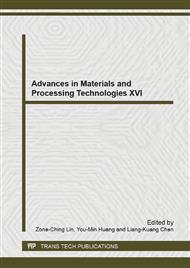p.539
p.547
p.555
p.563
p.570
p.577
p.584
p.592
p.600
Study on Utilizing Rapid Prototyping Technology to Build Oral and Maxillofacial Models
Abstract:
Traditional dental impression approach is not applicable to most of the oral and craniofacial trauma patients. Without a physical model, it is not easy to evaluate a patients fracture and occlusion, limiting the treatment process. Especially, the accuracy of the maxillofacial model for occlusion evaluation needs to meet strict clinical demands. Therefore, in this research, we attempted to use computed tomography (CT), without damaging the oral and craniofacial tissues of patients, together with image processing and Rapid Prototyping (RP) technique to obtain physical oral and maxillofacial models with high accuracy. Initially, a set of procedures of generating maxillofacial model was developed. CT images were segmented and converted to a CAD file by a commercial medical image processing software. RP technique was used to fabricate maxillofacial model. After comparison, the deviations were greater than clinical demands of less than 1 mm. After analyzing the sources of errors, issues of CT slice thickness, images threshold selection and editing, and RP fabrication were investigated to improve the accuracy. As a result, updated standard procedures were suggested to obtain RP maxillofacial models with higher accuracy. The improved average deviation can be reduced to 0.22 mm. The biological RP models with high accuracy generated in this research can be used to improve success rate and safety in a surgery, to reduce complications after the surgery, and to decrease the time and cost of treatment.
Info:
Periodical:
Pages:
570-576
Citation:
Online since:
May 2014
Authors:
Price:
Сopyright:
© 2014 Trans Tech Publications Ltd. All Rights Reserved
Share:
Citation:


